Budva is one of Montenegro’s most captivating travel destinations. This charming coastal town, known for its beautiful beaches, historic Old Town, and lively nightlife. It offers a perfect blend of relaxation and adventure. Whether you’re a history enthusiast, beach lover, or a foodie, Budva has a lot on tap.
source: Nomadic Samuel and That Backpacker via Samuel and Audrey YouTube channel
Audrey and I were fortunate to squeeze in a visit to Budva late in the tourist season. We practically had the place to ourselves. This is a far cry from when it can get packed in the summer. We found one of our cheapest Airbnb rentals of our entire trip and enjoyed having the beaches quiet. Some of the restaurants had already started to close for the season but we can still found places to eat. Overall, our experience here was the tranquil escape we desired.
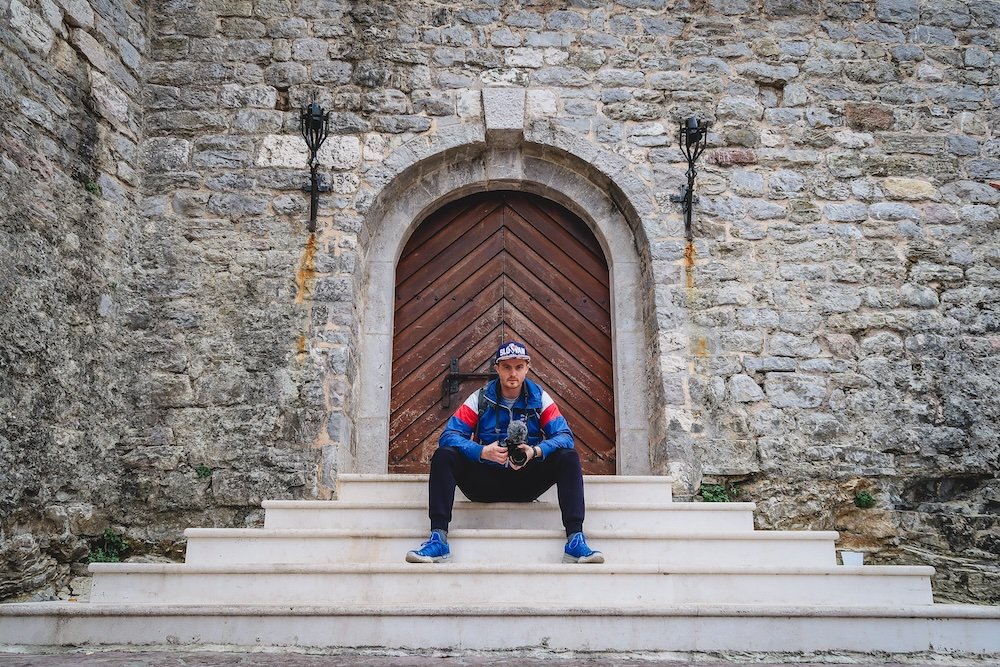
Why Visit Budva?
Budva is the perfect spot for those looking to experience the best of Montenegro’s coastline. From its medieval walls to its sandy beaches, the city combines ancient history with modern-day leisure. Whether you’re strolling through the cobblestone streets of the Old Town or lounging on a sun-kissed beach, Budva offers a mix of tranquility and excitement. It’s a place where you can dive into history during the day and dance under the stars at night.
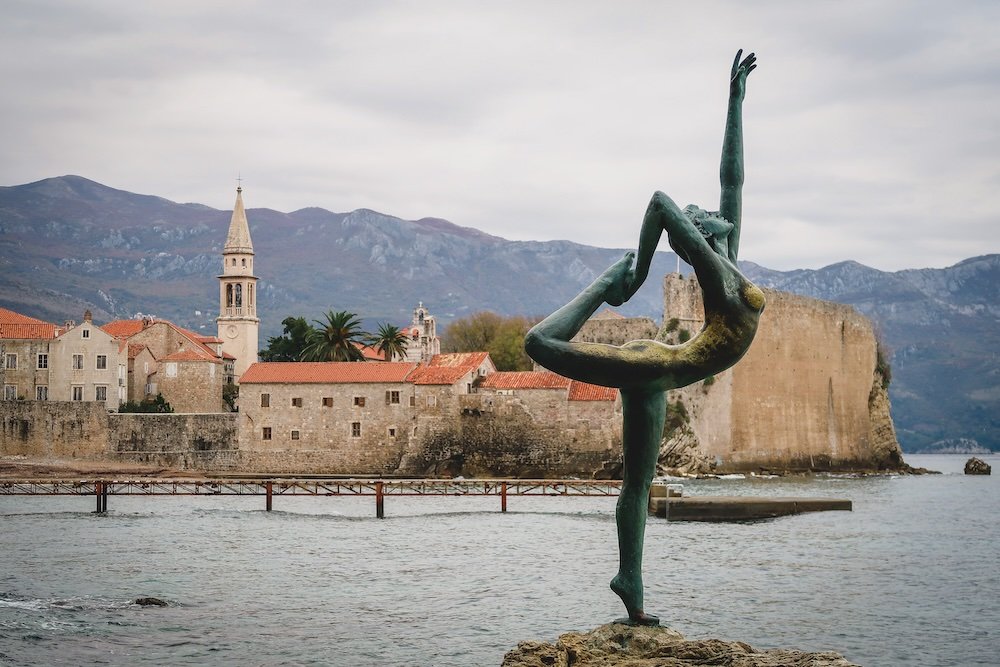
- Historic Old Town: Discover medieval charm with ancient walls, narrow alleys, and stunning views.
- Beautiful Beaches: Relax on some of the most famous beaches along the Adriatic Sea.
- Vibrant Nightlife: From beach clubs to rooftop bars, the party scene in Budva is buzzing.
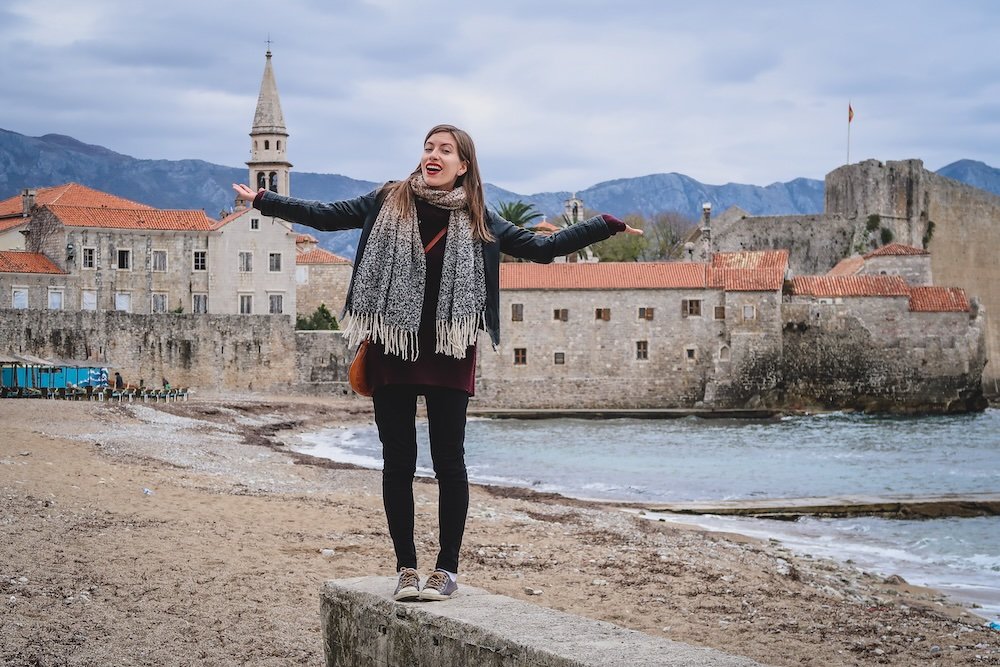
A Coastal Gem with a Rich History
Budva is often called the “Montenegrin Miami”, but it’s so much more than just a beach town. Its 2,500-year-old history makes it one of the oldest settlements on the Adriatic coast. The Old Town, or Stari Grad, is a perfectly preserved medieval city with fortress walls, museums, and quaint streets lined with cafes and shops. Wandering through this part of Budva feels like stepping back in time, offering a stark contrast to the modern resorts and vibrant nightlife that also define the city.
- Ancient Roots: Budva’s history spans over 2,500 years, making it one of the oldest Adriatic cities.
- Stari Grad: Explore ancient architecture, churches, and fortresses within the walled Old Town.
- Cultural Landmarks: Don’t miss the Citadel and the Church of St. John for a dose of history and panoramic views.
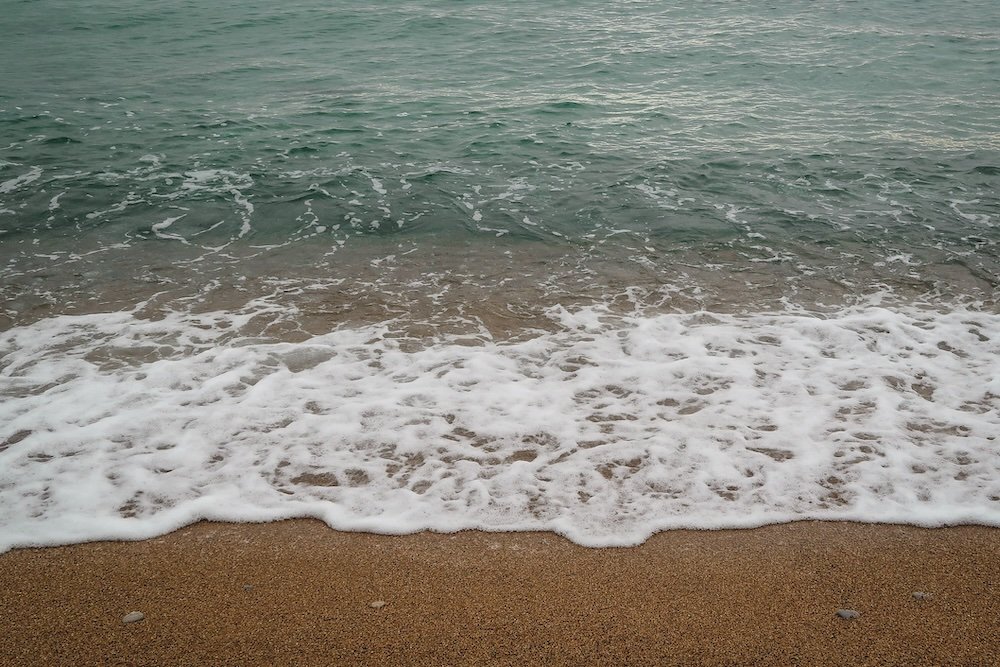
Beaches and Beyond
The beaches of Budva are the stuff of Adriatic dreams. With over 35 kilometers of coastline, there’s no shortage of sun-soaked spots to relax. The main beach, Slovenska Plaza, is perfect for families, while more secluded options like Mogren Beach or Jaz Beach provide quieter escapes. The water is clear, the sun is warm, and the views are unforgettable. If you’re into water sports, there’s no better place to jet ski, windsurf, or even try parasailing.
- Slovenska Plaza: A bustling beach ideal for families and those who want to be near the city action.
- Mogren Beach: A hidden gem with crystal-clear waters and surrounded by natural cliffs.
- Jaz Beach: Known for hosting music festivals and offering a laid-back beach experience.
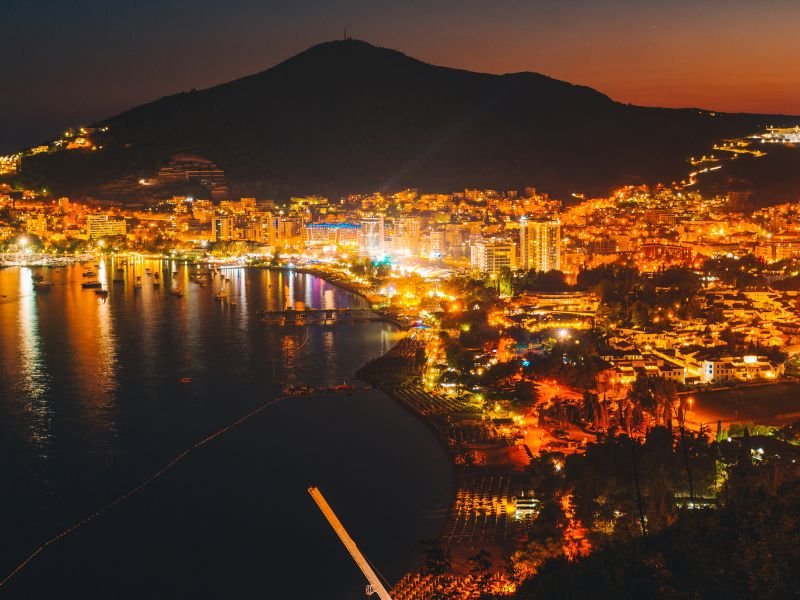
A City That Never Sleeps
After the sun sets, Budva transforms into a city that thrives on nightlife. From lively beach bars and clubs to sophisticated rooftop lounges, Budva offers a range of options to suit any night owl. Whether you’re sipping cocktails by the sea or dancing until dawn at a beachfront club, Budva’s party scene is renowned across the Adriatic. During the summer, the energy is contagious, drawing in crowds from all over the world.
- Beachfront Clubs: Dance the night away at one of Budva’s famous beach clubs.
- Rooftop Bars: Enjoy cocktails with a view at trendy spots around the city.
- Summer Festivals: Experience live music, international DJs, and more at Budva’s summer events.

Budva City Guide: A Brief History Of Budva, Montenegro
Budva’s history is as captivating as its scenic coastline. This ancient city, located on Montenegro’s Adriatic coast, has been continuously inhabited for over 2,500 years, making it one of the oldest settlements in the Balkans. From the Illyrians to the Greeks, Romans, Venetians, and Ottomans, Budva has seen numerous civilizations leave their mark.
source: Nomadic Samuel and That Backpacker from Samuel and Audrey on YouTube
Ancient Beginnings: From Illyrians to Romans
The roots of Budva stretch back to Illyrian times, when the area was first settled by the Illyrian tribes around the 5th century BC. The city’s strategic coastal position made it a key location for trade and defense, which soon attracted the Greeks and later, the Romans. Under Roman rule, Budva, known as Butua, flourished as a trading post and became a vital part of the empire’s coastal network.
- Illyrian Origins: The city’s ancient roots date back to the Illyrian tribes in the 5th century BC.
- Greek Influence: Budva became a hub for trade under Greek influence.
- Roman Empire: Known as Butua, it grew as a key Roman coastal city.
Tip: Visit the Roman Necropolis, just outside the Old Town, to see relics and tombs from this era.
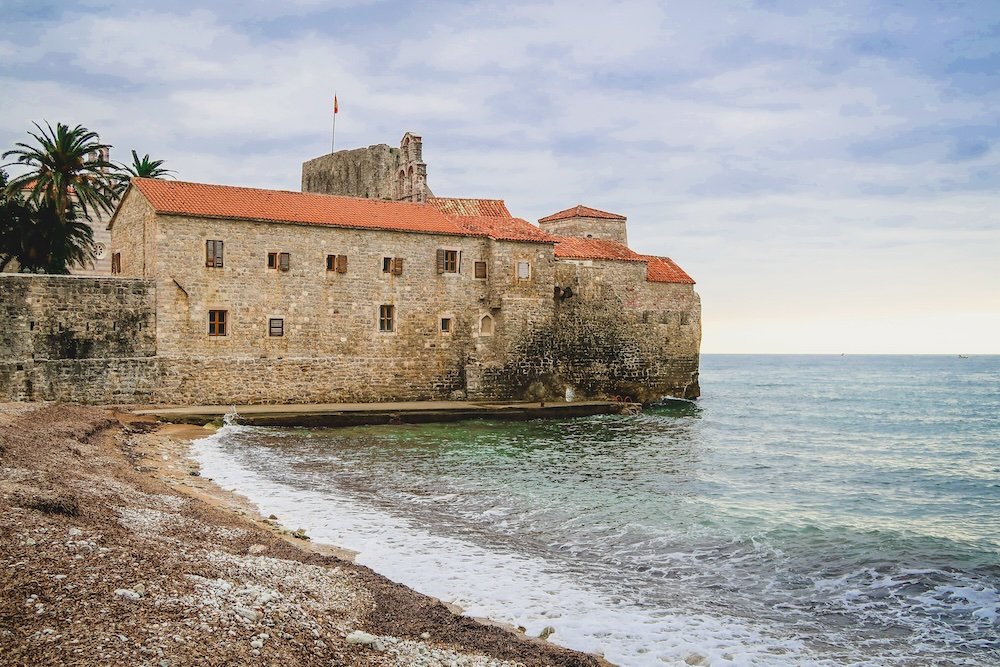
The Venetian Era: A Time of Fortifications
One of the most significant periods in Budva’s history came during the Venetian rule (1420–1797), when the city became a key fortress town. During this time, Stari Grad (Old Town) took its current shape, with high fortress walls and narrow cobblestone streets built to protect the city from attacks. The Venetian influence can still be seen in the city’s architecture today, especially in the Citadel, an impressive fortress that stands proudly over the sea.
- Venetian Influence: Budva’s architecture was heavily shaped by its time under Venetian rule.
- Stari Grad Fortifications: The city walls and streets we see today were built during this period.
- The Citadel: A must-see for history lovers, offering panoramic views of the Adriatic.
Tip: Climb up to the Citadel for not only a dose of history but also stunning views over the coastline and Old Town.
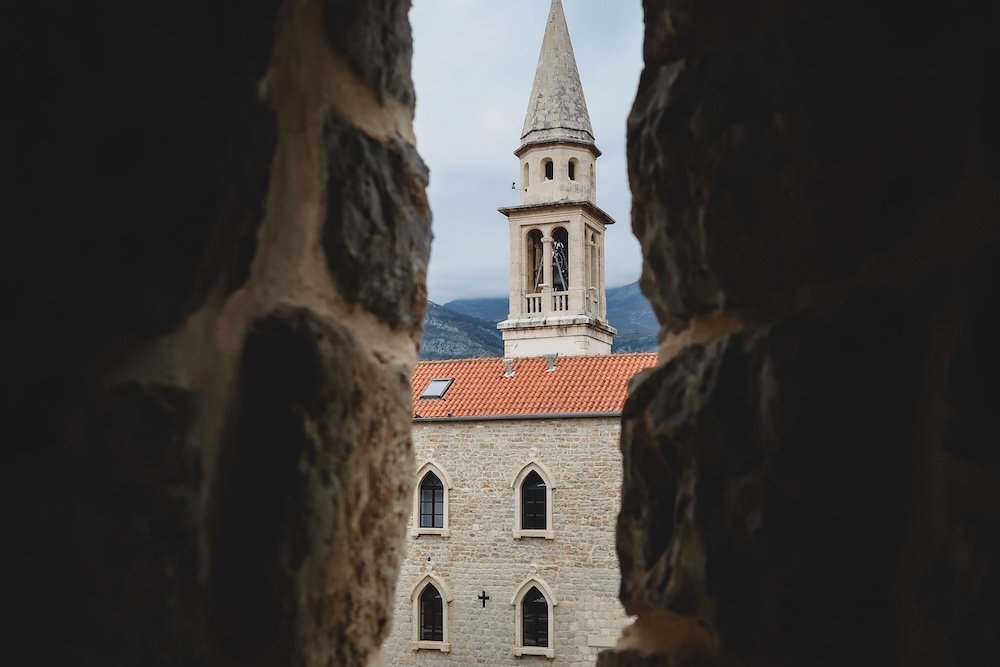
Ottoman Conquests and Earthquakes
Following the decline of the Venetian Republic, Budva faced a turbulent period. The city was briefly controlled by the Ottomans in the 16th century, leaving it vulnerable to repeated attacks. Natural disasters also took their toll, with the 1667 earthquake causing massive damage to the Old Town. Yet, Budva managed to rebuild and retain much of its historical character, blending different influences from each era of its occupation.
- Ottoman Period: Though brief, it left an imprint on Budva’s historical landscape.
- Natural Disasters: The 1667 earthquake destroyed much of the city, but it was quickly rebuilt.
- Resilient History: Despite challenges, Budva preserved its ancient structures and atmosphere.
Tip: As you walk the streets of Stari Grad, you can still see how the town was reconstructed after the 1667 earthquake.
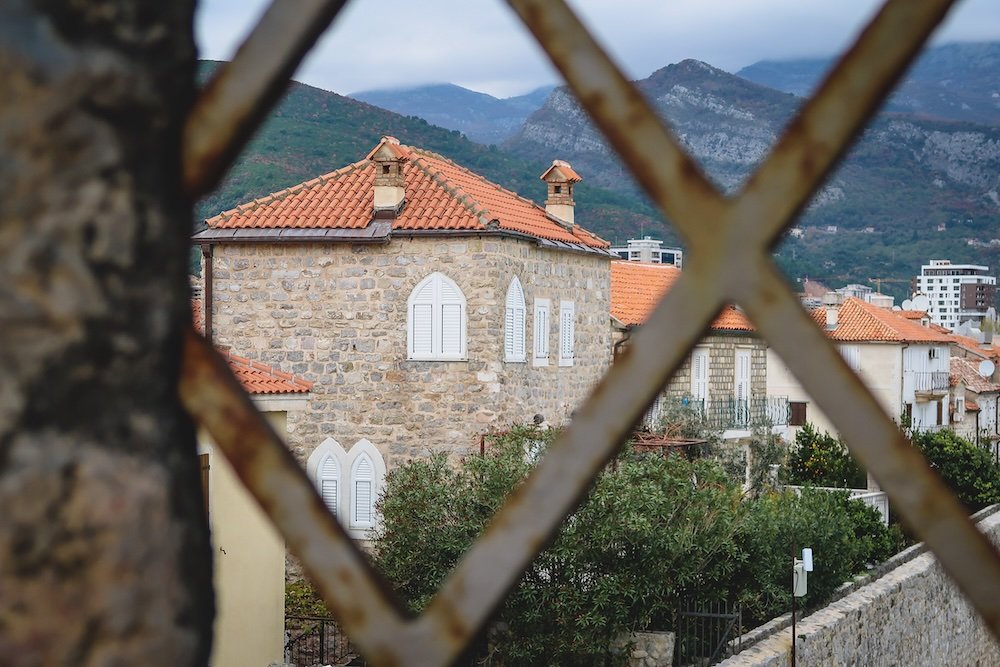
Modern Times: From Yugoslavia to Independence
In the 20th century, Budva was incorporated into Yugoslavia, and like the rest of the region, it experienced the political and social upheavals that came with it. After the breakup of Yugoslavia in the 1990s, Montenegro eventually declared its independence in 2006. Today, Budva is not only a hub for tourism but also a proud city with deep cultural roots, a blend of ancient and modern influences, and a thriving Mediterranean charm that continues to attract visitors from around the globe.
- Yugoslav Era: Budva became part of Yugoslavia during the 20th century.
- Montenegrin Independence: After Montenegro’s independence in 2006, Budva became a key part of its tourism revival.
- Modern Day: Today, Budva is a bustling blend of history, culture, and modern-day attractions.
Tip: Visit Budva in July to experience the Budva Theatre City Festival, where the town transforms into an open-air stage, celebrating its vibrant past and present.
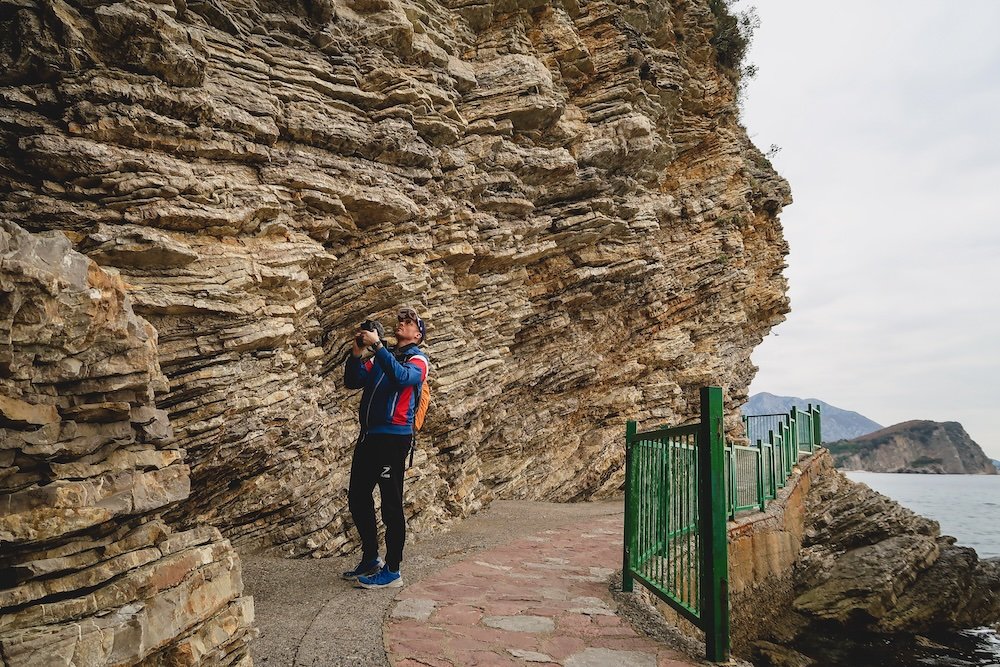
Budva Top Attractions and Best Places to Visit in Montenegro
Marketed as Montenegro’s answer to the crowded beaches and islands of Croatia, the Budva Riviera has become better known in recent years. With the Old Town charms of other towns along the Adriatic Coast, and a fortunate position close to the second largest river canyon system in the world, this coastal resort city is an excellent place to enjoy the sun after exploring the culture of interior regions in the Balkans.
While you may have beaches on your mind, start your time in Montenegro’s finest coastal resort area by touring the Old Town of Budva. The ancient settlement was founded on an island joined to the mainland by a sand bar more than 2,500 years ago, but it was during the times of the Venetian Empire that fortifications were built to protect the residents that dwelled within its confines.
Starting in the 14th century, a system of ramparts, walls and gates were erected to protect against external threats, and with a bit of luck over the past 600 years, much of it has survived to the present day.
Apart from examining the Old Town’s defenses, a number of interesting churches (the Church of St. John has the Madonna in Punta, which is a notable icon worth seeing if you are into religious relics), cosy alleys and the usual assortments of shops, restaurants and bars can be found within.

More Attractions
If you are seeking a truly noteworthy religious point of interest in the area though, making a trip outside town to the Podmaine Monastery should be added to your travel itinerary. Built in the 15th century as a Serbian Orthodox Monastery, this sight is best known for its frescoes, one of which has attracted a fair bit of controversy over the years.
After an earthquake in 1979, the older frescoes in one of the smaller churches on site was remade to depict the heads of the rival Montenegrin Orthodox Church and Yugoslav dictator Tito as heretics that were being led to hell by agents of Satan. Political commentary aside, the present day grounds of the monastery are a peaceful place, making it a great place to spend part of an afternoon when exploring Budva.
While the reinforced walls around the Old Town of Budva served as enough of a deterrent to military forces from the medieval and Renaissance periods, the latter half of the 19th century brought about the need for new defenses that could cope the modernization of warfare.
The Kosmac Fortress, built high above the city of Budva, served as a defensive point to protect the region against any potential incursions by the Austro-Hungarian Empire, as the border between this regional power and Montenegro was not far from the city.
While the structure is in a state of disrepair, fans of grit and military history will love it, while others should visit solely for the photo opportunities of Budva below, and the Adriatic beyond it.
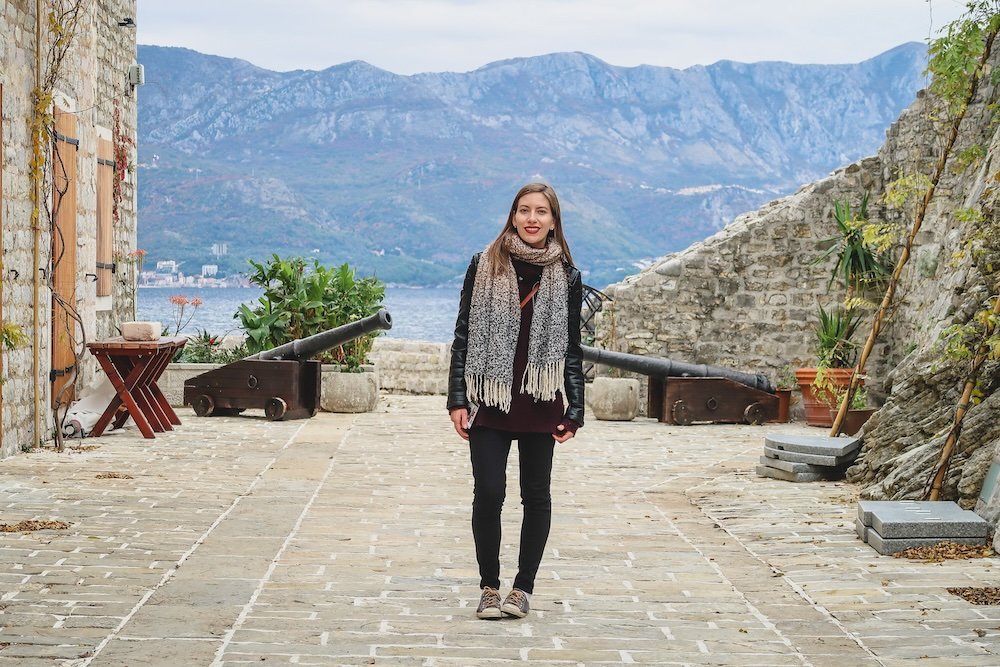
Other Cultural Attractions: Trip to Budva, Montenegro
Spanning across the world’s largest canyon outside of the Grand Canyon in the USA, the Tara Bridge is a popular destination for those seeking out some of the most dramatic natural scenery in the Budva Riviera. While shutter bugs will be happy enough to take multiple photos of this place from various angles, those seeking something a bit more active will find plenty to do here, as there are opportunities to white water rafting in the Tara River below, or soar along a zipline with hundreds of metres of dead air beneath them.
There are many beaches in Budva area that serve as the main draw for many visiting the region, but if you don’t want to be paralyzed by choice, then settling on Ploce Beach will prove to be a wise decision. It is a lively place, with many pool bars for those looking to party the day away, while there is plenty of incentive for those that wish to go swimming to do so, as the crystal clear waters and smooth stones will surely make it a memorable experience.
If the crowds at the beach are interfering with your need for serenity, you can pursue it by taking a boat trip over to the Island of St. Nicholas. While you can soak up the rays on one of three beaches (one of which is clothing-optional), you can also go for a hike up its lofty backside, where many birds and small mammals can be sighted.
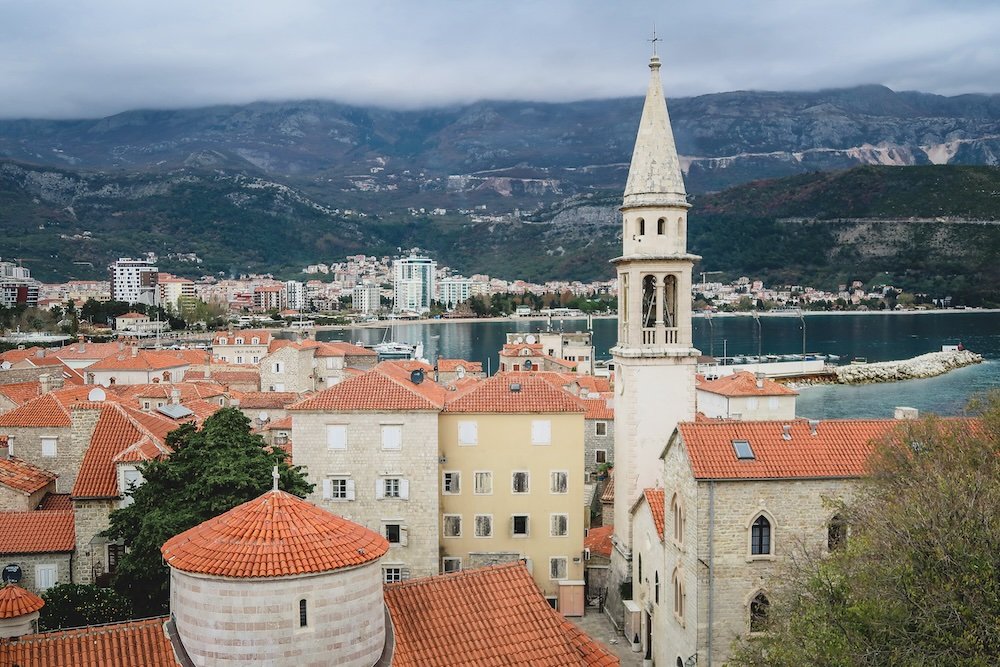
Top 20 Things To Do in Budva, Montenegro For Visitors
Here are the top 20 things to do in Budva, Montenegro:
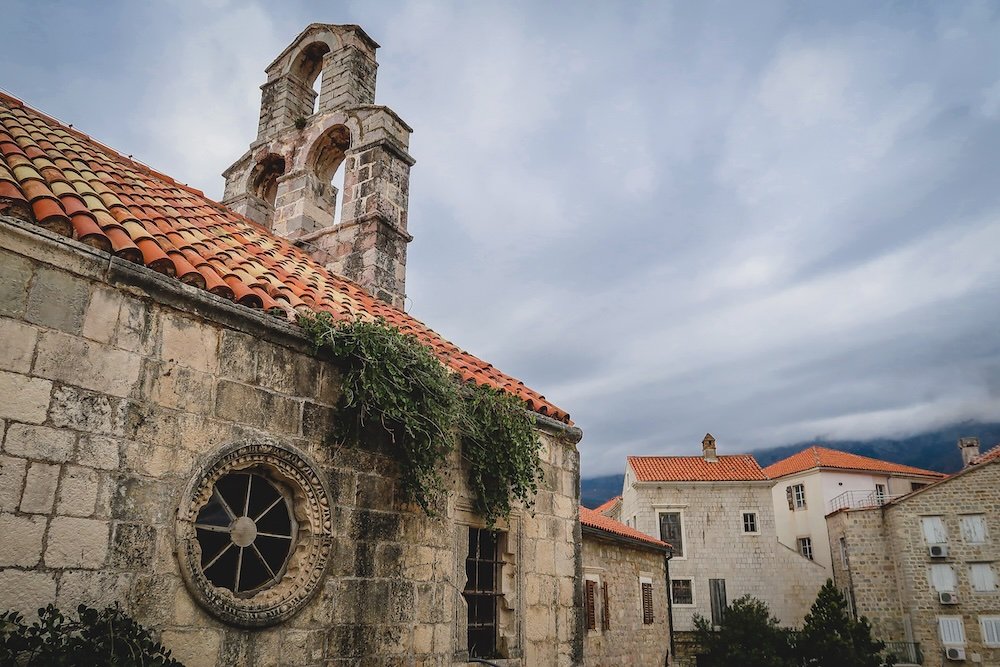
1. Explore the Old Town
Budva’s Old Town is a beautifully preserved area with medieval stone walls, narrow cobbled streets, and historic buildings. Walking through its maze-like layout, you’ll find hidden cafes, shops, and squares. The highlight is the Citadel, which offers breathtaking views of the Adriatic Sea. It’s the perfect spot to soak in the blend of history and architecture that defines Budva.
- Wander cobblestone streets lined with historic charm.
- Visit the Citadel, offering panoramic sea views.
- Explore hidden shops and cafes, scattered throughout the Old Town.
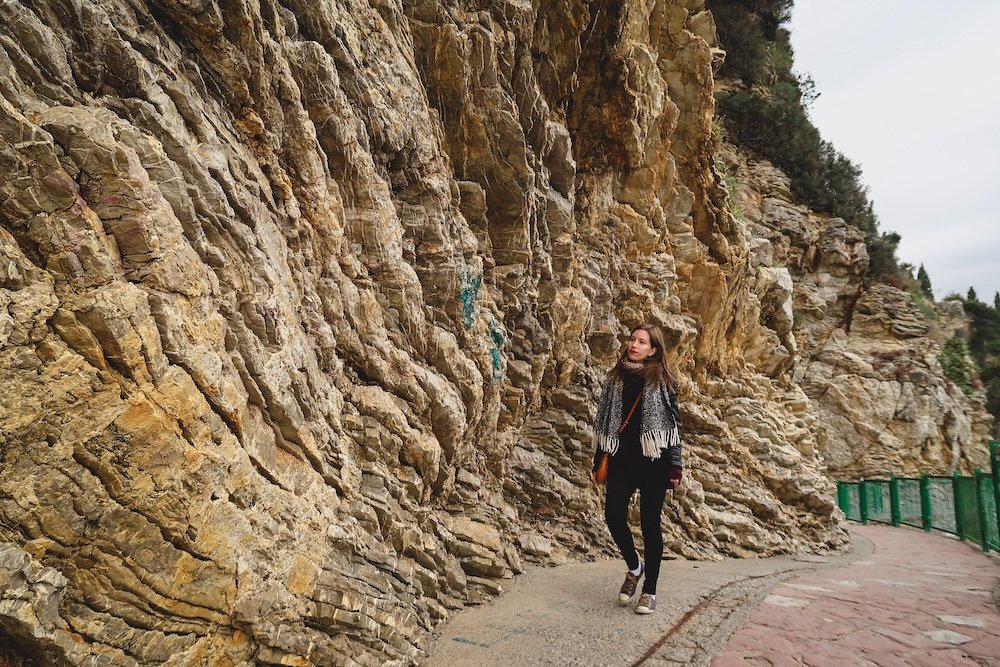
2. Relax on Mogren Beach
Nestled at the base of rugged cliffs, Mogren Beach is one of Budva’s most beautiful beaches. It consists of two sandy coves connected by a tunnel carved into the rocks. The beach is ideal for swimming, sunbathing, or just relaxing by the crystal-clear waters. Access is easy from the Old Town, making it a favorite among visitors.
- Enjoy two connected coves, perfect for swimming.
- Relax on the golden sand, surrounded by scenic cliffs.
- Stroll the short coastal path, with stunning sea views.
3. Visit Sveti Stefan Island
Sveti Stefan is an iconic island-turned-luxury resort, connected to the mainland by a narrow strip of land. Although access to the island is limited to hotel guests, you can admire its beauty from nearby beaches and viewpoints. This picturesque spot offers gorgeous sunsets and a glimpse of Montenegro’s elite accommodations. Its postcard-worthy appearance makes it one of Budva’s most famous landmarks.
- Admire the picturesque island, once a historic fishing village.
- Watch the sunset, offering incredible views of the island.
- Relax at nearby beaches, with views of Sveti Stefan.
4. Walk Along the Budva Riviera
The Budva Riviera stretches along the coast, offering scenic views, beaches, and lively promenade walks. The pathway is ideal for morning strolls or evening sunset views, lined with beach bars and restaurants. Along the way, you’ll find art installations, statues, and endless vistas of the Adriatic. For a true taste of Budva, stop by one of the restaurants to try the fresh seafood.
- Take a stroll along the Riviera, enjoying Adriatic views.
- Discover sculptures and art, dotted along the promenade.
- Stop for fresh seafood at beachside restaurants.
5. Enjoy the Nightlife
Budva is famed for its vibrant nightlife, offering something for every type of partygoer. From beach bars to world-class clubs like Top Hill, the city pulses with energy after dark. The Old Town also transforms with live music and cozy bars that cater to those looking for a more relaxed evening. During summer, the nightlife scene comes alive with festivals and beach parties.
- Visit Top Hill, one of Europe’s top nightclubs.
- Enjoy live music and drinks in the Old Town’s vibrant spots.
- Attend beach parties and summer festivals for a lively experience.
6. Visit the Maritime Museum
Located in the Old Town, the Maritime Museum offers an intriguing look into Budva’s seafaring history. The exhibits display old maps, ship models, and navigational instruments that highlight the town’s connection to the sea. You’ll also find traditional costumes and artifacts that show the maritime culture of the Adriatic. It’s a must-see for those interested in the history of seafaring and shipbuilding in Montenegro.
- Learn about Budva’s maritime history through fascinating exhibits.
- View old navigational tools, ship models, and historical maps.
- Discover traditional Adriatic seafaring culture in a charming setting.
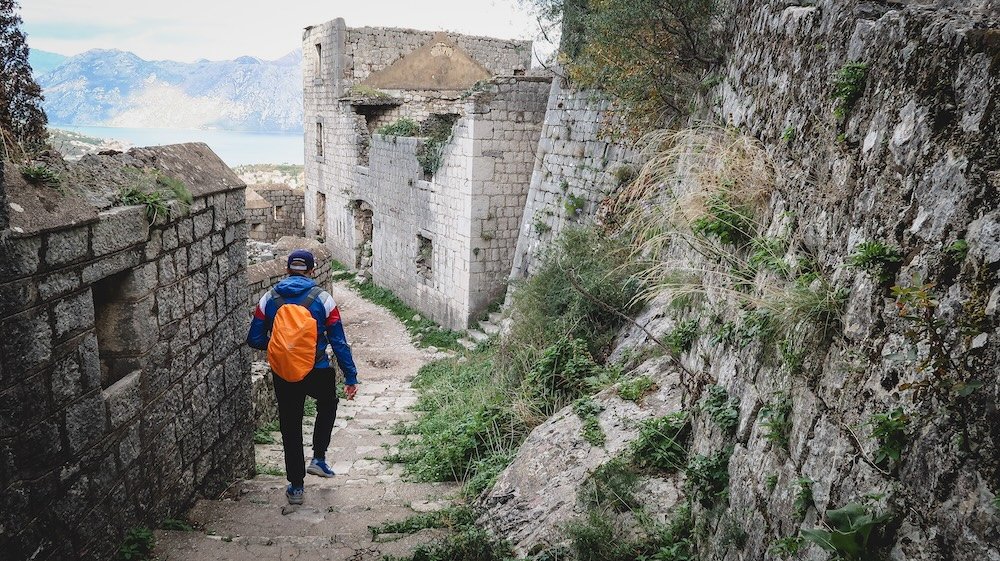
7. Take a Day Trip to Kotor
Just a short drive from Budva, Kotor is a UNESCO World Heritage site known for its fortified medieval town and stunning bay views. Wander through Kotor’s narrow streets, climb the ancient fortress walls, or visit its beautiful cathedral. The scenic drive from Budva to Kotor offers incredible coastal vistas, making this day trip a must-do.
- Climb the ancient fortress for panoramic views of Kotor Bay.
- Explore Kotor’s charming Old Town, filled with cafes and history.
- Take in the stunning coastal scenery on the drive from Budva.
8. Dive into Aquapark Budva
For family fun, Aquapark Budva offers a variety of water slides, pools, and attractions. Located on a hill with panoramic views of the sea, it’s the perfect place to cool off and enjoy the day. The park features restaurants, bars, and relaxation areas, ensuring fun for both kids and adults. Whether you’re racing down slides or floating in a lazy river, it’s a great day out.
- Enjoy a wide range of water slides and pools for all ages.
- Relax in designated lounge areas, with stunning views.
- Take a break at one of the park’s cafes or snack bars.
9. Attend the Sea Dance Festival
Held annually on Jaz Beach, the Sea Dance Festival is an award-winning music festival that brings together international artists and DJs. The festival’s setting on the Adriatic coastline adds to the unique experience, with attendees enjoying live music against the backdrop of the sea. Camping on the beach is part of the fun, allowing festival-goers to immerse themselves fully in the atmosphere.
- Listen to world-renowned artists and DJs, performing live.
- Dance the night away, with the Adriatic as your backdrop.
- Camp on Jaz Beach, adding to the festival experience.
10. Discover the Monastery of Podmaine
Located in the peaceful hills above Budva, the Monastery of Podmaine is a serene retreat with a long history. The complex includes a church, dining hall, and living quarters for monks, all surrounded by beautifully maintained gardens. Known for its frescoes and quiet atmosphere, it’s a place of spiritual reflection. Visitors are welcome to explore the grounds and attend services.
- Visit the peaceful monastery, set in beautiful gardens.
- Admire the ancient frescoes, rich in history and spirituality.
- Explore the serene surroundings, offering a quiet escape from the town.
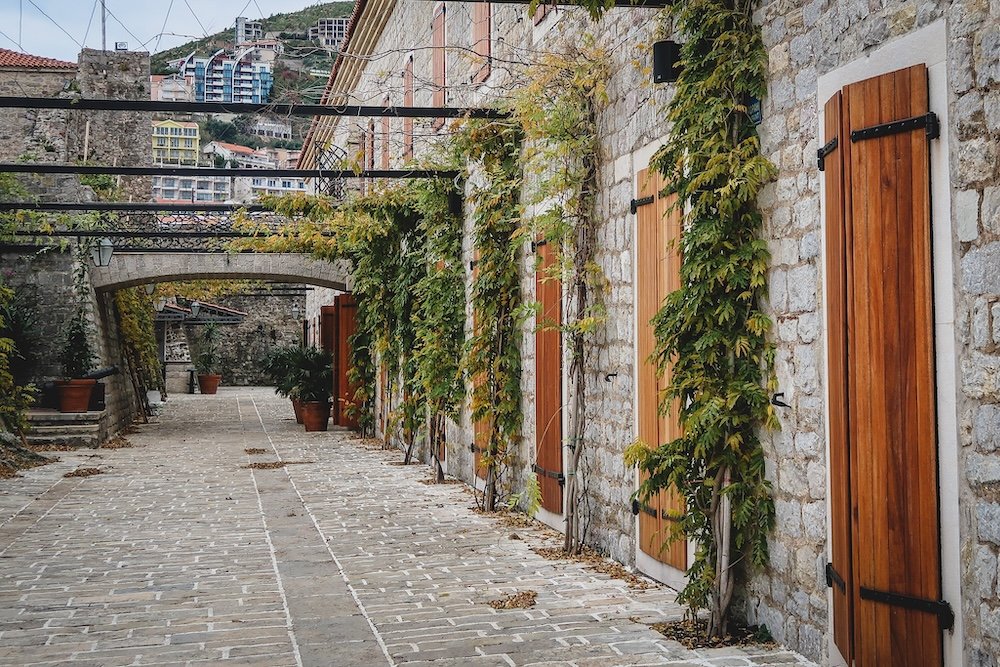
11. Shop at the Local Markets
Budva’s local markets are the perfect place to explore Montenegrin culture, offering fresh produce, handmade crafts, and authentic souvenirs. You’ll find local specialties such as smoked ham, cheeses, and delicious olive oil, all sourced from the surrounding region. Strolling through the markets provides a glimpse of everyday life in Budva, with opportunities to interact with local vendors. It’s a lively spot to pick up unique gifts and try traditional foods.
- Discover local Montenegrin specialties, like smoked ham and cheese.
- Shop for handmade crafts and authentic souvenirs.
- Experience daily life in Budva, by interacting with local vendors.
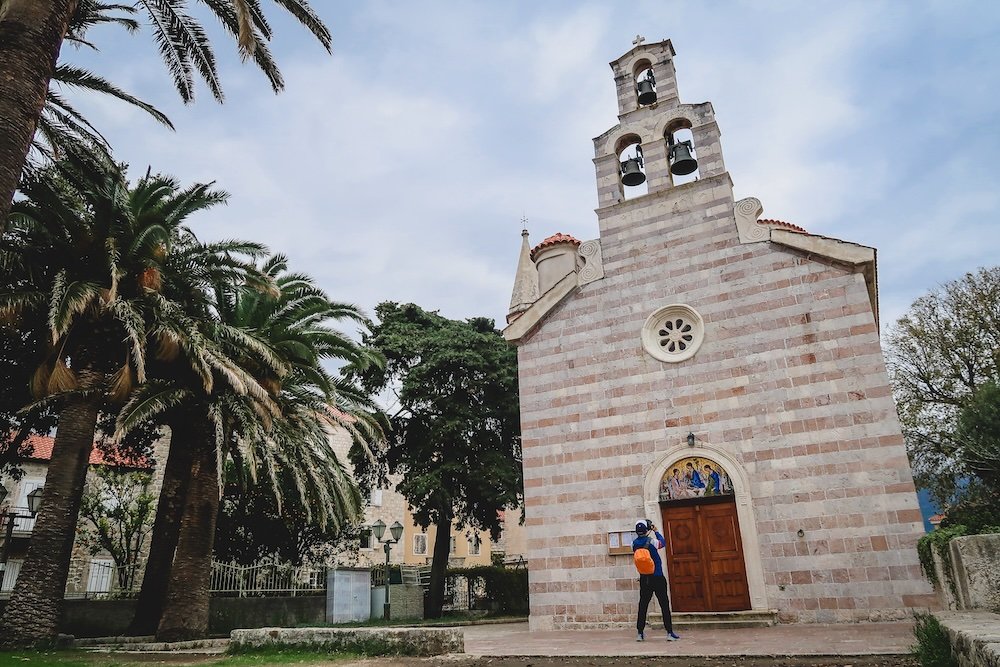
12. Visit the Church of Santa Maria in Punta
Santa Maria in Punta, one of Montenegro’s oldest pre-Romanesque churches, sits quietly within Budva’s Old Town. Built in the 9th century, it’s a beautiful example of early Christian architecture, offering a serene place to reflect. Inside, the ancient frescoes provide insight into religious history. The church also hosts cultural events and concerts, adding a layer of artistic appreciation to its historical significance.
- Admire the ancient frescoes and early Christian architecture.
- Attend cultural events, often held within the church.
- Experience a peaceful atmosphere, perfect for contemplation.
13. Explore Ploce Beach
Ploce Beach is a popular beach known for its rocky outcrops, crystal-clear waters, and a vibrant beach club. The beach features swimming pools, waterslides, and plenty of space for lounging, making it a favorite among locals and visitors. The lively beach bar and DJ sets create a fun atmosphere for sunbathing and socializing. Its unique landscape offers natural pools and beautiful views, perfect for those looking for a relaxing yet energetic beach day.
- Swim in crystal-clear waters, surrounded by rocky cliffs.
- Enjoy beach club amenities, like pools and waterslides.
- Soak in the vibrant atmosphere, complete with music and DJ sets.
14. Hike to the Kosmač Fortress
Perched atop a hill, the Kosmač Fortress provides panoramic views of the Budva Riviera and surrounding mountains. Built by the Austrians in the 19th century, the fortress ruins offer a glimpse into the area’s military history. The hike to the fortress is rewarding, with scenic paths passing through olive groves and hillsides. It’s an ideal spot for photography, nature lovers, and history buffs.
- Hike through scenic landscapes, including olive groves.
- Explore the ruins of a 19th-century fortress, rich in history.
- Capture panoramic views of the Budva Riviera and mountains.
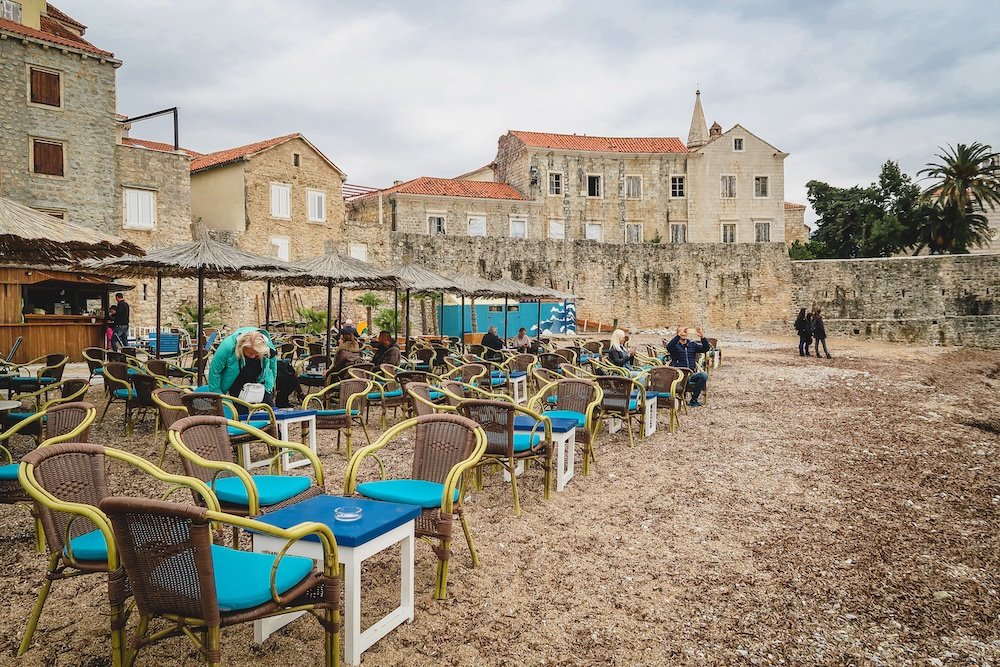
15. Enjoy Local Cuisine
Budva’s culinary scene showcases the flavors of Mediterranean and Montenegrin cuisine, with an emphasis on fresh seafood and regional specialties. Restaurants in the Old Town and along the waterfront serve grilled fish, squid, and traditional dishes like Njegusi ham and cevapi. Dining al fresco, especially with a view of the Adriatic, makes for a memorable experience. Budva’s blend of seafood and local ingredients reflects the richness of Montenegrin food culture.
- Savor fresh seafood, including grilled fish and squid.
- Try traditional dishes, such as Njegusi ham and cevapi.
- Dine al fresco, with views of the Adriatic Sea enhancing the experience.
16. Visit the Modern Gallery
The Modern Gallery in Budva showcases contemporary Montenegrin art, offering a glimpse into the country’s creative culture. The gallery features paintings, sculptures, and multimedia works by emerging local artists. With frequent temporary exhibitions and cultural events, it’s a dynamic space that attracts art lovers. The modern art collection provides insight into Montenegro’s artistic evolution and its growing role in the global art scene.
- Explore contemporary Montenegrin art, from paintings to multimedia.
- Attend temporary exhibitions, showcasing new talent.
- Discover the modern art movement within Montenegro.
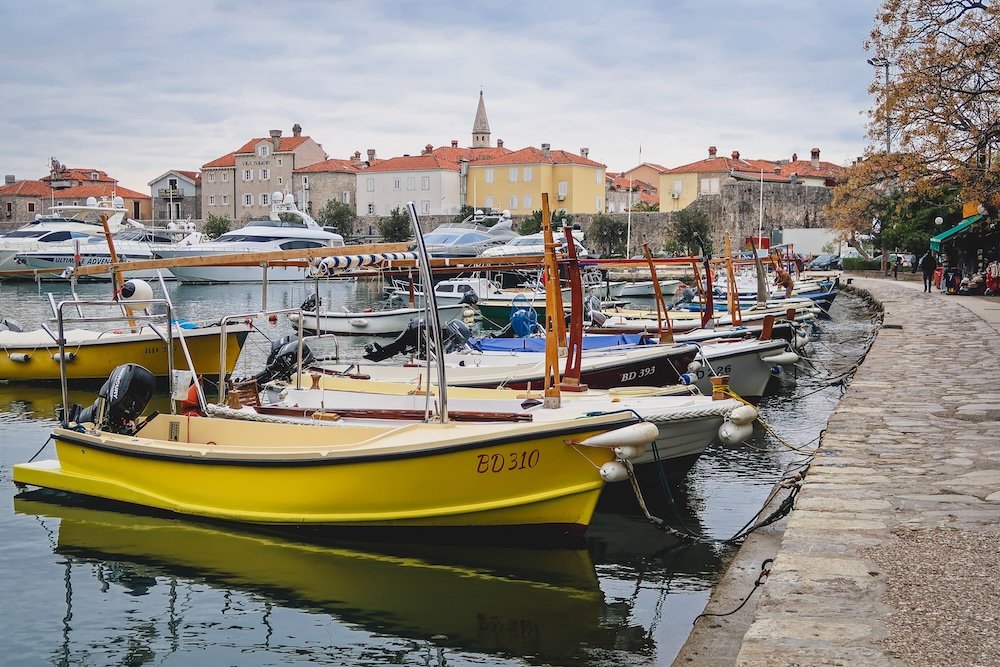
17. Take a Boat Tour to the Blue Cave
A boat tour to the Blue Cave on the Luštica Peninsula offers one of the most beautiful natural experiences in Montenegro. The cave is famous for its electric blue waters, which glow when sunlight filters through the underwater entrance. Boat tours often include stops at secluded beaches and other hidden gems along the coast. Swimming and snorkeling in the Blue Cave’s radiant waters is an unforgettable experience.
- Marvel at the glowing blue waters inside the Blue Cave.
- Swim or snorkel in one of Montenegro’s most stunning natural spots.
- Explore nearby beaches on a scenic boat tour along the Adriatic coast.
18. Relax at Slovenska Beach
Slovenska Beach, located along Budva’s waterfront, is one of the busiest and most convenient beaches in the city. It offers a wide promenade lined with shops, cafes, and restaurants, making it perfect for a relaxing day by the sea. The beach is equipped with sunbeds, umbrellas, and plenty of options for water sports. In the evenings, the promenade comes alive with street performers, creating a lively and vibrant atmosphere.
- Relax on a sunbed while enjoying the beach’s lively atmosphere.
- Stroll the promenade, with shops and cafes lining the way.
- Experience street performances, adding energy to the evenings.
19. Experience Budva’s Carnival
Held every summer, Budva’s Carnival is a colorful and lively event that celebrates Montenegrin culture with parades, music, and performances. The streets fill with dancers, musicians, and costumed performers, creating a festive atmosphere. The carnival attracts visitors from all over Europe and highlights Budva’s cultural and artistic diversity. Watching the parades or joining the celebrations is a fantastic way to immerse yourself in the local spirit.
- Watch colorful parades, showcasing Montenegrin culture.
- Enjoy live music and performances, throughout the streets of Budva.
- Join in the carnival spirit, with events attracting visitors from all over Europe.
20. Climb to the Top of the Budva Citadel
The Budva Citadel, located in the Old Town, offers breathtaking views over the Adriatic Sea and the town below. The climb to the top is rewarding, with panoramic vistas perfect for photography. Inside the citadel, visitors can explore a maritime museum and a collection of historical artifacts. The citadel also hosts cultural events, making it a site rich in both history and entertainment.
- Climb to the top for panoramic views of Budva and the Adriatic.
- Explore the maritime museum, located inside the citadel.
- Attend cultural events, often held within the historical fortress.

What To Eat and Drink in Budva, Montenegro
Budva’s food scene is a delicious reflection of its Mediterranean roots. From seafood lovers to meat enthusiasts, and even those with a sweet tooth, there’s plenty on offer.
1. Fresh Seafood by the Adriatic
It’s no surprise that seafood is a star in Budva, given its prime location along the Adriatic coast. Restaurants throughout the city serve a wide range of freshly caught fish, calamari, shrimp, and mussels, often simply grilled or served with olive oil, lemon, and local herbs. Whether you’re enjoying a casual meal at a beachside tavern or a fancy dinner at an upscale restaurant, seafood is a must-try in Budva.
- Grilled Fish: Fresh Adriatic fish like sea bass or sea bream, grilled to perfection and served with vegetables.
- Buzara: A traditional Montenegrin dish made with mussels or shrimp, cooked in a flavorful sauce of white wine, garlic, and herbs.
- Calamari: Grilled or fried, calamari is a popular starter or main course that pairs perfectly with a glass of local wine.
Tip: Head to one of the restaurants in Old Town or along the Budva Riviera for the freshest seafood, often caught that very morning.
2. Traditional Montenegrin Meat Dishes
While seafood is a big draw, Montenegrin cuisine also celebrates hearty meat dishes, many of which reflect the Balkan influence in the region. Lamb, veal, and pork are often slow-cooked or grilled, resulting in tender, flavorful meals that will leave you feeling satisfied after a long day of exploring.
- Ćevapi: Grilled minced meat sausages, served with fresh bread, onions, and ajvar (a roasted red pepper sauce).
- Jagnjetina Ispod Sača: A traditional lamb dish cooked under a metal bell, resulting in incredibly tender, juicy meat with crispy skin.
- Ražnjići: Skewered and grilled pork or lamb, often served with a side of potatoes and fresh salad.
Tip: For a truly authentic Montenegrin dining experience, seek out a konoba (traditional tavern) where local recipes are passed down through generations.
3. Njeguški Prosciutto and Local Cheeses
A culinary highlight not to be missed is Njeguški pršut, Montenegro’s famous dry-cured ham from the village of Njeguši. Typically served with local cheeses, olives, and bread, it’s a perfect starter or a light snack to enjoy with a glass of Montenegrin wine. The smoky, savory flavor of Njeguški prosciutto, combined with the creamy, mild cheeses, creates a mouthwatering combination you’ll want to savor again and again.
- Njeguški Pršut: A local delicacy, similar to Italian prosciutto but with a distinct smoky flavor.
- Local Cheeses: Soft, fresh cheeses often made from sheep or cow’s milk, served alongside olives and tomatoes.
- Olives and Olive Oil: Montenegro is known for its high-quality olives and olive oil, which are often featured as accompaniments.
Tip: Visit one of the many markets or delis in Budva where you can sample and even take some prosciutto and cheese home as souvenirs.
4. Montenegrin Wine and Rakija
A meal in Budva wouldn’t be complete without sampling the region’s local beverages. Montenegro produces excellent wines, particularly Vranac, a robust red wine that pairs beautifully with meat dishes. For something a little stronger, try rakija, a traditional fruit brandy often made from grapes, plums, or apricots. It’s served at the start or end of a meal and packs a flavorful punch.
- Vranac Wine: A bold red wine that’s famous throughout Montenegro, often enjoyed with red meat dishes.
- Krstač Wine: A light, refreshing white wine that pairs perfectly with seafood.
- Rakija: A potent fruit brandy, often homemade, served as a traditional aperitif or digestif.
Tip: Many restaurants offer local wine tastings, giving you the chance to explore Montenegrin wines paired with your meal.
5. Sweet Treats and Desserts
No meal is complete without something sweet! Montenegrin desserts often feature honey, nuts, and fruit, making for simple yet satisfying treats. Priganice, or fried dough balls drizzled with honey, are a popular choice for those with a sweet tooth. Another favorite is krempita, a light, fluffy custard pastry, often enjoyed with a coffee after dinner.
- Priganice: Delicious fried dough balls, typically served with honey or jam.
- Krempita: A custard-filled pastry with a delicate, flaky crust.
- Baklava: The Balkan classic, featuring layers of filo pastry, nuts, and sweet syrup.
Tip: Pair your dessert with a cup of Montenegrin coffee, which is rich, strong, and often served in a traditional džezva (coffee pot).
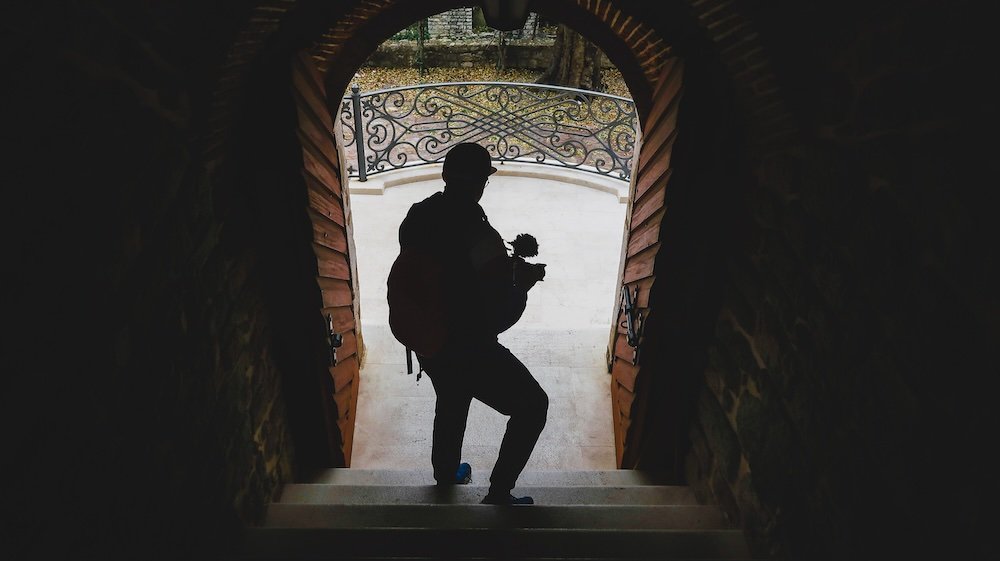
Tours For Visitors To Budva, Montenegro
Whether you’re interested in diving deep into the city’s medieval past, cruising the Adriatic Sea, or discovering nearby hidden gems, Budva has a wide range of tours to fit most tastes.
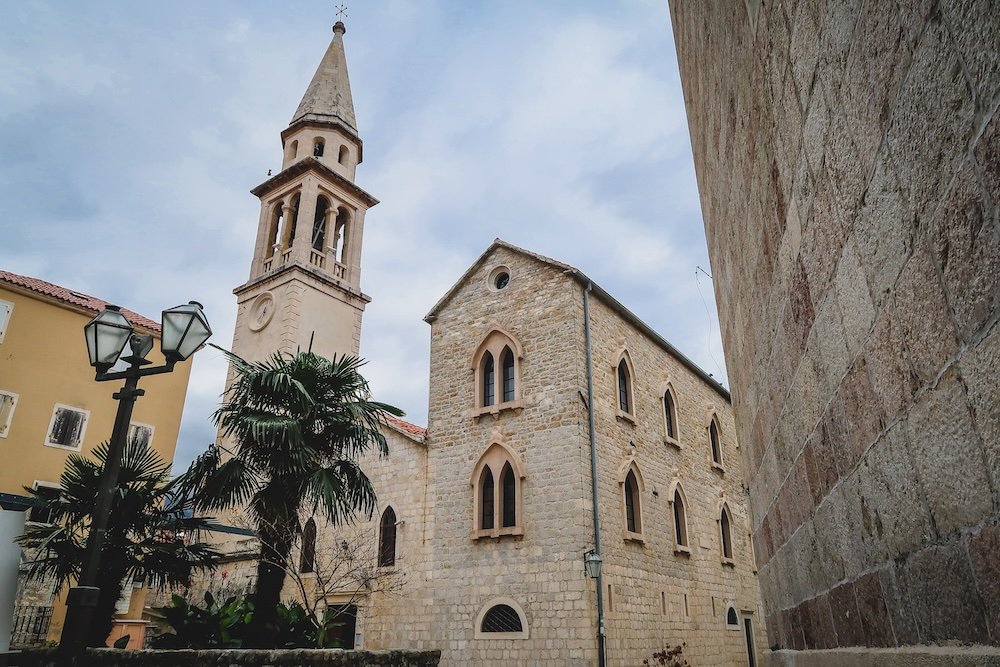
1. Old Town Walking Tour
There’s no better way to immerse yourself in Budva’s history than with a guided Old Town walking tour. As you stroll through the cobblestone streets of Stari Grad, you’ll uncover the city’s 2,500-year history. From the Citadel to the Church of St. John, this tour is an enriching journey through time. A local guide will lead you through the maze of ancient alleys, pointing out key landmarks and sharing stories of Venetian rule, pirate attacks, and local legends.
- Citadel Fortress: Explore this historic structure that once protected the city from invaders.
- Church of St. John: Visit this beautiful church, a symbol of Budva’s spiritual history.
- Ancient City Walls: Walk along the medieval walls for panoramic views of the Adriatic Sea.
Tip: Book a sunset walking tour to see the Old Town bathed in golden light, followed by a relaxing evening by the sea.
2. Budva Riviera Boat Tour
For breathtaking views of the Adriatic Sea and a day of fun on the water, hop on a Budva Riviera boat tour. These tours take you along the coast, offering views of secluded beaches, charming villages, and dramatic cliffs. You can swim in crystal-clear waters, snorkel, or just relax as you cruise past some of the most beautiful scenery Montenegro has to offer. Many boat tours also stop at nearby islands, such as the iconic Sveti Stefan.
- Island of Sveti Stefan: Admire this stunning islet, a former fishing village turned luxury resort.
- Hidden Coves and Beaches: Swim and relax at some of Montenegro’s hidden gems, only accessible by boat.
- Water Sports: Some tours offer snorkeling and paddleboarding for an added dose of adventure.
Tip: Bring your camera—the coastal views are some of the most picturesque in all of Montenegro!
3. Montenegro Wine Tour
For wine lovers, a Montenegro wine tour is a must! Budva is just a short drive from some of the country’s best vineyards, where you can sample local wines like the bold Vranac and the crisp Krstač. A typical wine tour will take you through the lush Montenegrin countryside, where you can visit family-owned wineries, learn about local winemaking traditions, and, of course, taste some exceptional wines. Many tours also include traditional Montenegrin dishes to complement the tasting experience.
- Vranac Wine: Try Montenegro’s famous red wine, known for its rich, bold flavors.
- Local Vineyards: Visit small, family-run wineries where wine production has been passed down for generations.
- Montenegrin Cuisine: Enjoy local cheese, prosciutto, and other Montenegrin delicacies with your wine tasting.
Tip: Consider booking a private tour for a more intimate and personalized experience.
4. Lovćen National Park and Mausoleum Tour
For a day trip full of history and natural beauty, consider a tour to Lovćen National Park, located less than an hour from Budva. The park is home to the Njegoš Mausoleum, the final resting place of Petar II Petrović-Njegoš, one of Montenegro’s most beloved leaders and poets. After climbing the 461 steps to the mausoleum, you’ll be rewarded with stunning panoramic views of Montenegro’s rugged mountains and coastline.
- Njegoš Mausoleum: Visit this impressive monument located at the peak of Mount Lovćen.
- Hiking and Nature: Explore the park’s trails and enjoy the fresh mountain air.
- Breathtaking Views: Enjoy panoramic vistas stretching across Montenegro and the Adriatic Sea.
Tip: Make sure to wear comfortable shoes—the climb to the mausoleum is steep, but well worth it!
5. Kayaking and Snorkeling Adventure
For a more adventurous tour, opt for a kayaking and snorkeling excursion along Budva’s coast. These guided tours offer the chance to paddle through clear, turquoise waters while discovering hidden caves and beaches. Along the way, you’ll have the opportunity to stop and snorkel, exploring the underwater world of the Adriatic Sea. It’s an active and refreshing way to enjoy Budva’s natural beauty from a different perspective.
- Sea Caves: Kayak into hidden sea caves for an exciting and unique experience.
- Snorkeling: Discover marine life beneath the Adriatic’s crystal-clear waters.
- Hidden Beaches: Paddle to secret beaches that are only accessible by kayak.
Tip: Bring plenty of sunscreen and a hat—you’ll be out on the water for a few hours!
6. Budva Nightlife Tour
For those looking to experience the vibrant nightlife that Budva is famous for, a nightlife tour is the perfect way to dive in. Budva has a reputation for being one of the liveliest party spots along the Adriatic, with beach bars, clubs, and rooftop lounges bustling well into the early morning hours. A guided nightlife tour will take you to the best spots in town, offering insider tips on the best places to enjoy cocktails, music, and dancing.
- Beachfront Clubs: Dance the night away at Budva’s famous beach clubs, like Top Hill and Trocadero.
- Rooftop Bars: Sip cocktails while enjoying panoramic views of the city at trendy rooftop lounges.
- Live Music: Catch a live music performance at one of the local bars or taverns.
Tip: Many clubs and bars don’t get busy until after midnight, so pace yourself for a late night out!
source: That Backpacker and Nomadic Samuel on Samuel and Audrey YT Channel
Budva Accommodations Guide: Hotels, Guesthouses and Hostels
Let’s dive into some of the best places to stay in Budva, Montenegro.
1. Luxury Hotels: Experience the Adriatic in Style
Budva is home to several high-end hotels that promise an indulgent stay, combining modern amenities with the stunning backdrop of the Adriatic Sea. If you’re looking to pamper yourself, you’ll find no shortage of luxurious beachfront resorts offering private pools, fine dining, and easy access to the city’s vibrant nightlife. These hotels are perfect for travelers seeking a combination of comfort and elegance.
- Hotel Avala Resort & Villas: Located just steps from the Old Town, this beachfront resort offers stylish rooms, a gorgeous infinity pool, and a spa for ultimate relaxation.
- Dukley Hotel & Resort: Perched on a private peninsula, this five-star hotel provides panoramic sea views, an exclusive beach club, and spacious, modern suites.
- The Chedi Lustica Bay: While a bit outside Budva, this luxurious retreat offers seclusion and a contemporary Mediterranean design that’s worth the short trip.
Tip: Many luxury hotels in Budva offer packages that include spa treatments or boat tours, so be sure to check for special deals when booking.
2. Guesthouses: Local Charm and Comfort
For a more authentic Montenegrin experience, consider staying in one of Budva’s many guesthouses. These family-run accommodations are often located in or near the Old Town, giving you easy access to historical landmarks, restaurants, and the beach. Guesthouses offer a cozy and personal touch, with hosts who are often happy to provide local tips and recommendations to make your stay even more special.
- Villa Perla di Mare: A charming guesthouse located just outside the Old Town, offering comfortable rooms with a warm, welcoming atmosphere.
- Apartments Popovic: These centrally located apartments offer a mix of comfort and convenience, with rooms featuring balconies overlooking the town.
- Villa M Palace: Set in a quiet area, this guesthouse combines modern amenities with Montenegrin hospitality, perfect for those seeking a peaceful retreat.
Tip: Guesthouses often offer homemade breakfast or local delicacies, so don’t miss the chance to try traditional Montenegrin dishes during your stay.
3. Hostels: Budget-Friendly and Social
If you’re a budget traveler or simply looking for a social experience, Budva’s hostels are a great way to meet fellow adventurers while keeping costs low. With their central locations and friendly atmospheres, hostels offer a lively home base for exploring the city’s attractions, beaches, and nightlife. Many hostels also organize group activities, pub crawls, and tours, making it easy to connect with other travelers.
- Freedom Hostel Budva: Located in the heart of the Old Town, this hostel is perfect for those looking to be close to the action. It’s known for its social vibe, with pub crawls and organized group activities.
- Montenegro Hostel 4U: Just a stone’s throw from Slovenska Beach, this hostel offers budget-friendly dorms, a lively atmosphere, and easy access to the beach.
- Hostel Budva: Situated a bit outside the bustling Old Town, this hostel offers a more relaxed atmosphere with friendly staff, perfect for those who want a quiet retreat after a day of exploration.
Tip: Look out for hostels that offer free walking tours of Budva or discounts on local attractions—an excellent way to stretch your travel budget.
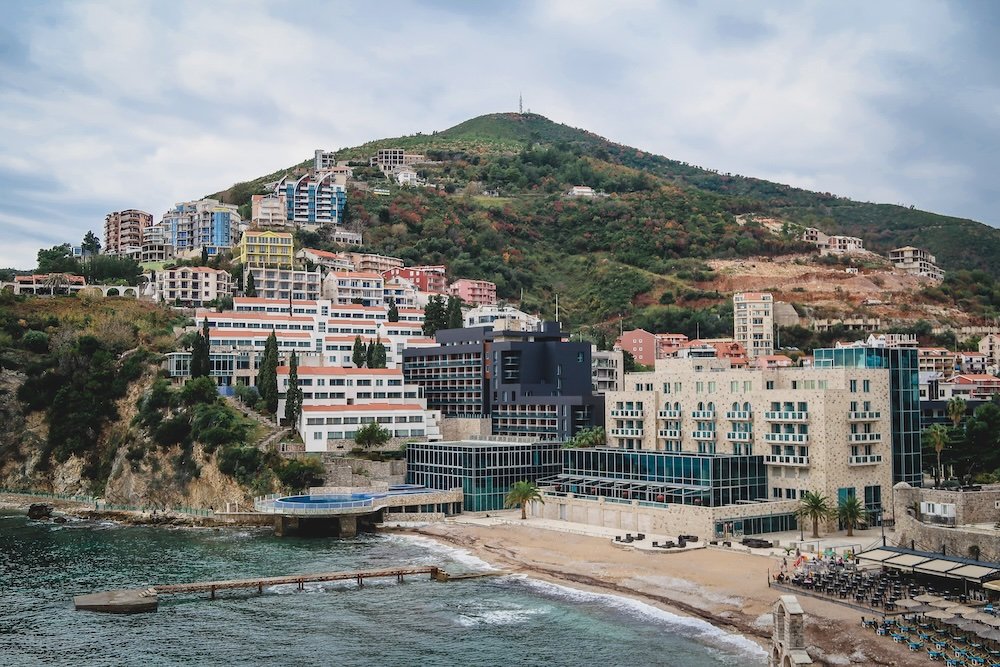
4. Apartments: Flexibility and Convenience
For those who prefer a little more privacy or the convenience of having their own kitchen, renting an apartment in Budva is a great option. Many vacation rentals and apartments are available throughout the city, from modern flats in the heart of Budva to more secluded spots with stunning sea views. Apartments offer the flexibility of self-catering and are ideal for families, groups, or longer stays.
- Budva Centar Apartments: Modern apartments in the city center, offering spacious accommodations and fully equipped kitchens—perfect for families or extended stays.
- Apartments Vila Balkan: Located near the Old Town, these apartments provide stunning views of the sea and the historical city, making for a perfect backdrop to your stay.
- Sea Breeze Apartments: Just a short walk from the beach, these cozy apartments offer both comfort and convenience, with balconies overlooking the Adriatic.
Tip: When booking an apartment, consider its proximity to supermarkets or local markets for easy access to fresh produce and local goods.
5. Boutique Hotels: A Unique Stay with a Personal Touch
If you’re after something a bit more unique, Budva has a growing number of boutique hotels that combine style, comfort, and personalized service. These smaller hotels often offer a more intimate experience, with beautifully designed rooms and thoughtful touches that make your stay special. Boutique hotels are ideal for couples or travelers seeking something charming and different.
- Hotel Astoria: Nestled in the heart of the Old Town, this boutique hotel blends historical charm with modern luxury. Its rooftop terrace offers stunning views of the Adriatic.
- Hotel Budva: Situated right on the seafront, this boutique hotel offers elegant rooms and an unbeatable location, just steps from the beach and Budva’s main attractions.
- Boutique Hotel Arka: A charming, small hotel with modern amenities, located close to both the beach and the Old Town. Known for its friendly service and chic design.
Tip: Many boutique hotels in Budva offer exclusive experiences like private dinners or curated tours, so don’t hesitate to inquire about extra services when booking.
Day Trips From Budva, Montenegro
Here are some of the best day trips you can take from Budva to make the most of your Montenegrin adventure.
source: Nomadic Samuel and That Backpacker duo on Samuel and Audrey channel
1. Kotor: A UNESCO-Listed Gem
Just a 30-minute drive from Budva, Kotor is a must-visit for history buffs and nature lovers alike. This picturesque town, nestled at the foot of towering mountains, boasts a UNESCO World Heritage-listed Old Town filled with medieval architecture, winding streets, and historic landmarks. Take a hike up to the Kotor Fortress for panoramic views of the Bay of Kotor or explore the town’s beautiful squares and churches.
- Kotor Fortress: Climb the 1,350 steps to enjoy breathtaking views of the bay.
- Bay of Kotor: Take a boat trip around this stunning fjord-like bay.
- St. Tryphon’s Cathedral: Visit one of Montenegro’s most important religious sites, dating back to the 12th century.
Tip: Visit Kotor early in the day to avoid the crowds, especially if you’re planning to hike to the fortress.
source: That Backpacker and Nomadic Samuel teaming up on Samuel and Audrey YT
2. Perast and Our Lady of the Rocks
A short drive from Kotor, the charming village of Perast is another fantastic day trip option from Budva. Known for its well-preserved baroque architecture, Perast is also famous for its proximity to the iconic Our Lady of the Rocks, an artificial island with a 15th-century church that’s steeped in local legend. You can catch a boat from Perast to the island and explore its unique history.
- Our Lady of the Rocks: Visit this man-made island and its historic church and museum.
- Perast: Wander through the quaint streets of this scenic town.
- Boat Trips: Take a short boat ride to explore the islands of Our Lady of the Rocks and St. George.
Tip: Many organized tours from Budva combine visits to both Kotor and Perast, making for a full day of sightseeing.
3. Lovćen National Park: Nature and History Combined
If you’re seeking adventure and nature, head to Lovćen National Park, located just over an hour from Budva. The park is famous for Mount Lovćen, the dramatic peak that dominates the landscape, and the Njegoš Mausoleum, a monument dedicated to Montenegro’s national hero, Petar II Petrović-Njegoš. The hike or drive to the top offers awe-inspiring views of the surrounding mountains and coast, making this an unforgettable day trip.
- Njegoš Mausoleum: Climb 461 steps to reach this impressive mausoleum with stunning views.
- Mount Lovćen: Hike or drive through the park’s trails and enjoy breathtaking scenery.
- Adventure Activities: Try zip-lining or mountain biking through the park’s rugged terrain.
Tip: If you’re driving, be sure to take the Serpentine Road for some of the most scenic switchback turns and jaw-dropping views.
4. Skadar Lake: Birdwatcher’s Paradise
About an hour’s drive from Budva, Skadar Lake is the largest freshwater lake in the Balkans and a haven for birdwatchers and nature lovers. The lake straddles the border between Montenegro and Albania and is home to over 280 species of birds, including the endangered Dalmatian pelican. You can take a boat tour to explore the lake’s hidden islands, visit medieval monasteries, or simply enjoy a peaceful day surrounded by stunning natural beauty.
- Boat Tours: Explore the lake’s waters, islands, and monasteries.
- Birdwatching: Keep an eye out for rare species, including herons, pelicans, and eagles.
- Virpazar: This charming lakeside village is a perfect starting point for lake tours and local wine tastings.
Tip: Combine your visit to Skadar Lake with a wine tour of the Crmnica region, known for producing some of Montenegro’s finest wines.
5. Cetinje: The Old Royal Capital
For a deep dive into Montenegro’s rich history, visit Cetinje, the country’s former royal capital. Just a 45-minute drive from Budva, Cetinje is filled with museums, monasteries, and palaces that tell the story of Montenegro’s past. The National Museum of Montenegro and the Cetinje Monastery are both must-see sites, offering insights into the country’s art, culture, and religious history. The town itself is peaceful and charming, offering a more relaxed pace compared to the coastal towns.
- National Museum of Montenegro: Discover the country’s cultural and artistic heritage.
- Cetinje Monastery: Visit this important religious site, home to sacred relics.
- Blue Palace: The residence of Montenegro’s president, located in the heart of Cetinje.
Tip: Visit Cetinje in the morning, and pair it with a trip to Lovćen National Park for a perfect historical and natural day trip combination.
6. Porto Montenegro and Tivat: Glamour on the Adriatic
For those seeking a touch of luxury, a visit to Porto Montenegro in Tivat is an excellent choice. Just under an hour from Budva, this glamorous marina is often compared to Monaco for its sleek yachts, upscale restaurants, and designer boutiques. Spend the day strolling along the waterfront, enjoying a luxury yacht tour, or indulging in fine dining at one of the marina’s many chic restaurants.
- Porto Montenegro Marina: Stroll through this glamorous port lined with superyachts.
- Luxury Shopping: Browse high-end boutiques and enjoy the cosmopolitan atmosphere.
- Waterfront Dining: Dine at one of the stylish restaurants with stunning views of the Adriatic.
Tip: If you’re looking for a bit of adventure, combine your visit with a boat trip to nearby Blue Cave, a natural sea cave with stunning blue waters.
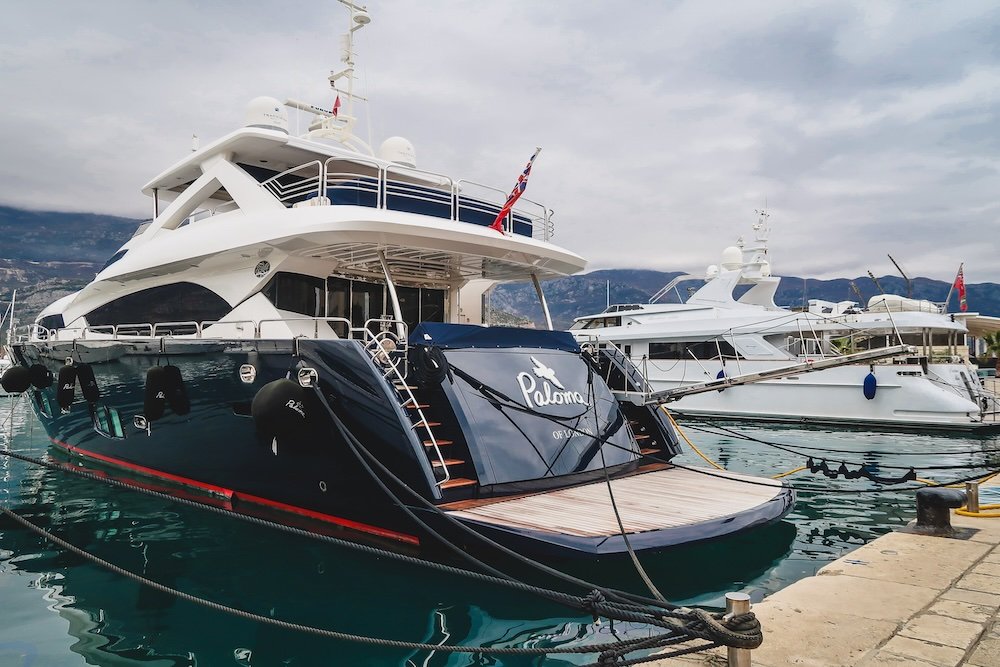
Budva Transportation Guide
Here’s a breakdown of the best ways to get around Budva, along with tips to ensure smooth travels during your stay.
1. Local Buses: Budget-Friendly and Convenient
Budva’s local bus network is an affordable and efficient way to get around the city and to nearby towns. The buses run frequently along the main routes, connecting Budva to its surrounding beaches, the Old Town, and other tourist hotspots. You can hop on a bus to visit popular places like Sveti Stefan, Becici, and even further afield to Kotor or Tivat.
- Cost-Effective: Bus fares are low, making this a budget-friendly option for visitors.
- Frequent Service: Buses run regularly, especially along the main coastal routes.
- Multiple Destinations: Easily reach key areas such as beaches, Old Town, and neighboring towns.
Tip: Bus schedules can vary, so check the local timetables at the main station or ask your hotel for up-to-date information.
2. Taxis: Fast and Accessible
For short trips within Budva or when you’re in a hurry, taxis are a great option. Taxis are readily available throughout the city, and many hotels and restaurants can call one for you. While not the cheapest mode of transport, taxis provide convenience and a quick way to get around, especially if you’re heading somewhere off the main bus routes. Just be sure to agree on the fare before your ride, as not all taxis use meters.
- Convenient: Taxis are available 24/7, perfect for quick and direct trips.
- Reliable: Good for getting to more remote locations or when public transport isn’t available.
- Negotiable Fares: Confirm the fare before starting your journey if the taxi does not have a meter.
Tip: Ride-hailing apps like Bolt operate in Budva and often offer more competitive rates than traditional taxis.
3. Car Rentals: Freedom to Explore
Renting a car is ideal if you’re planning to explore Montenegro at your own pace. With a rental car, you can easily reach Lovćen National Park, Skadar Lake, or even take scenic drives along the coast. Budva has several car rental agencies, and the roads are generally in good condition. However, parking in the Old Town can be tricky, so you may need to use paid parking lots.
- Flexibility: Perfect for travelers who want to explore at their own pace.
- Scenic Drives: Enjoy the stunning coastal roads and take day trips to nearby attractions.
- Easy Access: Plenty of car rental agencies available in Budva.
Tip: Be prepared for narrow, winding roads in more rural areas and ensure you have international insurance coverage.
4. Walking: Explore at Your Own Pace
Budva is a very walkable city, especially around the Old Town and the beachfront. Strolling through the cobblestone streets of Stari Grad or walking along the Budva Riviera is a great way to soak up the atmosphere and enjoy the scenic views. For shorter distances, walking is not only convenient but also a great way to discover hidden gems, from local shops to tucked-away cafes.
- Pedestrian-Friendly: Budva’s Old Town and beachfront are perfect for walking.
- Discover Hidden Spots: Explore the city’s charming streets and picturesque corners.
- Cost-Free: Walking is, of course, the cheapest way to get around!
Tip: Wear comfortable shoes as the streets in Old Town are cobbled, and some paths can be uneven.
5. Bikes and Scooters: An Active Alternative
For those who like a more active way to get around, renting a bike or scooter is a fantastic option. Several rental shops in Budva offer bikes, electric scooters, and even e-bikes, giving you a fun and eco-friendly way to explore the town. Riding along the Budva promenade or heading to nearby beaches like Mogren or Jaz on two wheels is both enjoyable and convenient.
- Eco-Friendly: Biking or scootering is a great way to stay active while reducing your carbon footprint.
- Flexible: Easily get around without worrying about parking or traffic.
- Affordable: Rental rates are generally inexpensive and available by the hour or day.
Tip: Stick to bike lanes and pedestrian paths where possible, especially during the busy summer season when traffic increases.
6. Ferries and Boat Transfers: Coastal Exploration
To explore Budva’s coastline or nearby islands, taking a boat or ferry is both a scenic and practical option. You can hop on boat transfers to Sveti Nikola Island or take ferry rides to visit other nearby coastal towns. Many local tour companies offer boat excursions, allowing you to combine sightseeing with a relaxing time on the water.
- Island Hopping: Take a boat ride to nearby islands and hidden beaches.
- Scenic Views: Enjoy panoramic views of the coastline from the sea.
- Relaxing: Combine transport with a leisurely day on the water.
Tip: Book boat tours early in the day, as they tend to fill up fast during the peak tourist season.
source: Nomadic Samuel and That Backpacker teaming up on Samuel and Audrey channel
Where To Visit After Your Trip To Budva?
Here are a few top picks to continue your Montenegrin adventure after your stay in Budva.
1. Herceg Novi: The Gateway to the Bay of Kotor
Located at the entrance of the Bay of Kotor, Herceg Novi is a charming coastal town known for its fortresses, botanical gardens, and laid-back atmosphere. With a rich history influenced by Venetians, Ottomans, and Austro-Hungarians, Herceg Novi’s Old Town offers a delightful blend of architectural styles. Stroll along the Pet Danica promenade, take a dip in the Adriatic, or visit one of the many fortresses scattered throughout the town.
- Pet Danica Promenade: A beautiful, 7-kilometer-long seafront walk lined with cafes and beaches.
- Forte Mare: A 14th-century fortress offering stunning views of the bay.
- Igalo: Famous for its healing mud baths and mineral springs, perfect for a wellness retreat.
Tip: Herceg Novi is a great starting point for a boat trip around the Blue Cave or to nearby Mamula Island.
2. Podgorica: The Capital City Experience
For a change of pace, head inland to Podgorica, Montenegro’s modern capital. Although often overlooked, Podgorica offers an intriguing blend of old and new, with its Ottoman-era architecture, museums, and bustling cafes. Visit the impressive Millennium Bridge, stroll through Gorica Park, or take a tour of Montenegro’s Wine Route, which starts just outside the city.
- Stara Varoš: Explore the remnants of Podgorica’s old town, with its mosques and narrow alleys.
- King’s Park: A peaceful green space perfect for a relaxing walk.
- Skaline (The Steps): A charming riverside area with cafes, ideal for enjoying coffee or a meal.
Tip: Don’t miss visiting the Niagara Falls of Montenegro (not to be confused with the famous ones in North America!), located just outside Podgorica.
3. Ulcinj: Montenegro’s Southern Gem
If you’re craving more beach time, Ulcinj is the place to go. Situated in the south of Montenegro, near the Albanian border, Ulcinj boasts the longest beach on the Adriatic coast—Velika Plaža. This 12-kilometer stretch of sand is perfect for swimming, sunbathing, and kitesurfing. Ulcinj also has a rich history, with an Old Town that dates back to ancient times and a long-standing reputation as a former pirate stronghold.
- Velika Plaža: The longest sandy beach in Montenegro, ideal for water sports and relaxation.
- Ada Bojana: A nearby island known for its nudist beaches and excellent seafood restaurants.
- Ulcinj Old Town: Wander through the ancient streets and explore its fortified walls and watchtowers.
Tip: For a unique experience, take a trip to Šas Lake, home to birdwatching opportunities and the ruins of Svač, an ancient city.
4. Tivat: Glamour and Tranquility
If you’re looking for a combination of glitz and natural beauty, Tivat is your next destination. Known for the luxury Porto Montenegro Marina, Tivat offers a more polished, upscale side of Montenegrin coastal life. But beyond the yachts and high-end boutiques, you’ll find beautiful beaches, quiet coves, and a peaceful atmosphere that’s perfect for unwinding after Budva’s bustling energy.
- Porto Montenegro: A luxury marina where you can admire super yachts and enjoy waterfront dining.
- Plavi Horizonti Beach: A serene beach surrounded by olive trees, perfect for a relaxing day.
- Gornja Lastva: A charming hillside village with traditional stone houses and beautiful views of the Bay of Kotor.
Tip: Tivat is also a great base for exploring the Vrmac Peninsula, which offers hiking trails with panoramic views of the Adriatic.
5. Žabljak: Adventure in the Durmitor National Park
For those looking to swap the sea for the mountains, Žabljak is the gateway to Durmitor National Park, a UNESCO World Heritage site and a haven for adventure seekers. Located in the north of Montenegro, Žabljak is perfect for hiking, rafting on the Tara River, or simply taking in the breathtaking views of Black Lake. It’s a completely different side of Montenegro, offering cool mountain air, dense forests, and high peaks.
- Tara River Canyon: Go white-water rafting through the second deepest canyon in the world.
- Black Lake: A stunning glacial lake surrounded by dense pine forests, ideal for hiking and picnicking.
- Durmitor Mountain: Hike to the summit of Bobotov Kuk, the highest peak in Montenegro.
Tip: Durmitor is just as beautiful in the winter, offering skiing and snowboarding for winter sports enthusiasts.
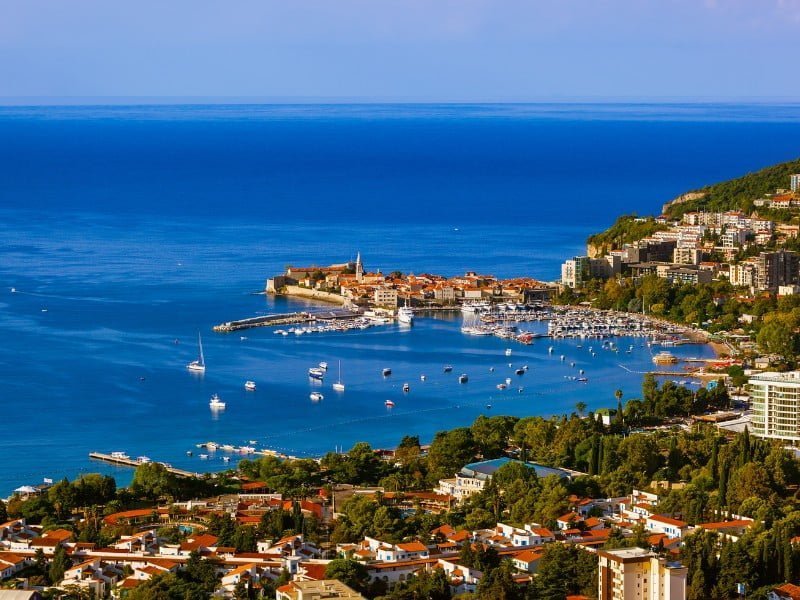
Budva Travel Guide: Final Thoughts
Budva is more than just a seaside getaway—it’s a destination that combines stunning beaches, rich history, and vibrant culture all in one.
Why Budva Should Be on Your Travel List
Budva’s appeal lies in its versatility. You can spend your days lounging on crystal-clear beaches, exploring ancient fortresses, or getting lost in the narrow streets of Stari Grad. And when the sun sets, Budva transforms into a nightlife hotspot, with its bars, clubs, and beach parties in full swing. Whether you’re looking for relaxation, adventure, or cultural immersion, Budva delivers in every way.
- Stari Grad (Old Town): A beautiful blend of history and charm that’s perfect for wandering and discovering hidden gems.
- Budva Riviera: From Slovenska Beach to the hidden coves of Mogren, the coast offers a wide variety of beach experiences.
- Nightlife: The energy of Budva comes alive after dark, with beach clubs and rooftop bars keeping the party going late into the night.
Tip: Try to visit Budva in the shoulder season (late spring or early fall) for fewer crowds and more affordable accommodations.
A Balanced Getaway
What makes Budva truly special is how it balances a laid-back atmosphere with moments of excitement. One moment you’re walking along the quiet, sun-drenched paths of the Budva Citadel, and the next, you’re experiencing the dynamic nightlife that keeps the city buzzing until dawn. This balance makes Budva perfect for those who want both rest and adventure in their travel plans.
- Relaxation: Spend your mornings enjoying coffee at a seaside café or exploring a local beach.
- Adventure: For thrill-seekers, head to Lovćen National Park for hiking or rent a kayak to explore the nearby islands.
- Culture: Take a day to wander through the museums, visit the local galleries, or watch a performance at the summer theater festivals.
Tips for a Smooth Stay
Getting the most out of your trip to Budva is all about planning a few key things in advance. Booking accommodations early, especially in the summer, is a must. Local buses and taxis make getting around easy, but consider renting a car if you want to explore beyond the city. Finally, embrace the local cuisine and enjoy every moment of this beautiful destination.
- Book Early: Accommodations fill up quickly during peak season, so secure your stay in advance.
- Transportation: Public buses are convenient, but renting a car offers more flexibility for day trips.
- Local Cuisine: Don’t leave without trying Montenegrin specialties like buzara or seafood risotto at one of the local taverns.
Budva is a coastal gem that will surprise and delight. Trust us—you’ll leave wanting more.
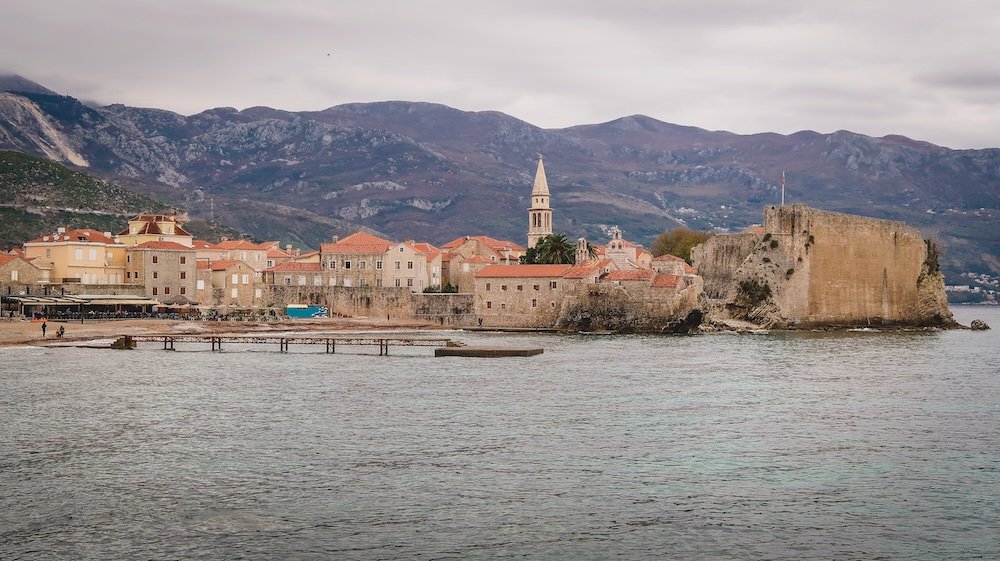
Ode To Budva
In the land where sun meets sea, Lies a coastal town, Budva by decree. With ancient walls and stories to tell, A destination where dreams can dwell.
Step into the Old Town’s embrace, Where history whispers in every space. Cobblestone streets lead the way, To secrets of the past, where memories sway.
The Adriatic’s azure hues, Glisten as the sun imbues. Beaches of golden sand invite, To bask in warmth and pure delight.
From Mogren to Jaz, the shores so fair, Where gentle waves caress with care. Sun-kissed days and balmy nights, A paradise where relaxation takes flight.
Indulge in flavors, a culinary delight, Seafood feasts that tempt the appetite. Montenegrin wines, a toast to cheers, Savoring moments that soothe and endears.
Adventure beckons, a world to explore, To Durmitor’s peaks, where eagles soar. Skadar Lake’s serenity, a tranquil retreat, Nature’s embrace, a sight so sweet.
From Sveti Stefan’s allure, To Lovćen’s heights, majestic and pure. Budva’s spirit, a vibrant blend, Where ancient and modern beautifully blend.
So come, wanderer, to Budva’s embrace, Where memories are woven with grace. Let the rhythm of the Adriatic’s beat, Guide your footsteps to this coastal retreat.
